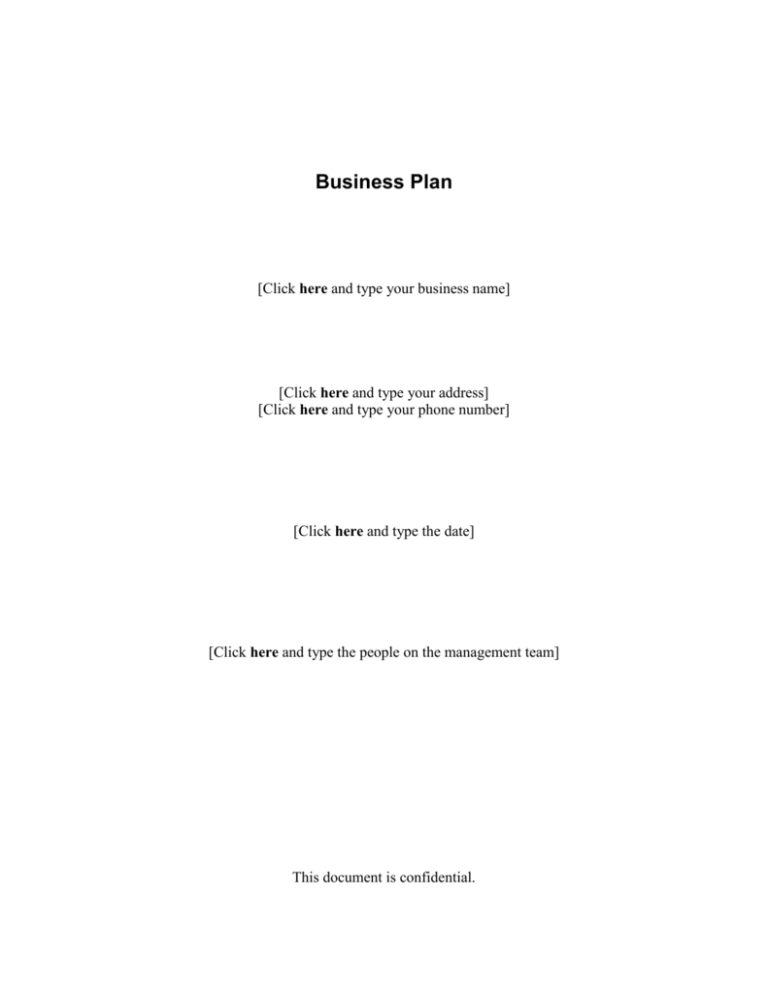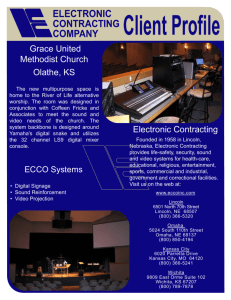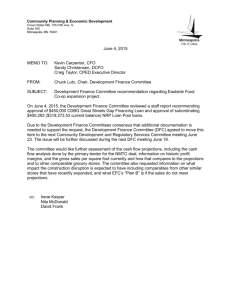BUSINESS PLAN TEMPLATE
advertisement

Business Plan [Click here and type your business name] [Click here and type your address] [Click here and type your phone number] [Click here and type the date] [Click here and type the people on the management team] This document is confidential. Table of Contents Table of Contents ................................................................................................................ 2 Executive Summary ............................................................................................................ 3 Vision/Mission Statement and Goals .................................................................................. 4 A. Vision Statement ........................................................................................................ 4 B. Goals and Objectives .................................................................................................. 4 C. Keys to Success .......................................................................................................... 4 Company Summary ............................................................................................................ 5 A. Company Background................................................................................................ 5 B. Resources, Facilities and Equipment ......................................................................... 5 C. Marketing Methods .................................................................................................... 5 D. Management and Organization .................................................................................. 5 E. Ownership Structure ................................................................................................... 5 G. Internal Analysis ........................................................................................................ 6 Products and/or Services ..................................................................................................... 7 Market Assessment ............................................................................................................. 8 A. External Analysis ....................................................................................................... 8 B. Customers ................................................................................................................... 8 C. Strategic Alternatives ................................................................................................. 8 Strategic Implementation .................................................................................................... 9 Financial Plan.................................................................................................................... 11 A. Financial Projections ................................................................................................ 11 B. Contingency Plan ..................................................................................................... 11 Monitoring .........................................................................Error! Bookmark not defined. 2 Executive Summary This section is a summary of the information from the pages that follow. Prepare it last, after the business plan has been written. It should not exceed two pages. Headings to use in the Executive Summary: A. Vision/Mission Statement B. Company Summary C. Products/Services D. Market Assessment E. Strategic Implementation F. Expected Outcomes 3 Vision/Mission Statement and Goals A. Vision Statement The vision/mission statements are clear summaries of where the business is headed. It describes what the business produces, who products are produced for, and unique business characteristics. It will reflect the values of the management team and the type of business culture you are trying to create. B. Goals and Objectives What do you want your business to achieve? Be specific in terms of financial performance, resource commitments (time and money) and risk. When will various milestones be achieved? C. Keys to Success What do you need, or must happen, for you to succeed? 4 Company Summary The material in this section is an introduction to the firm. A. Company Background What does your business do? Who were the founders of the business? What were the important milestones in the development of the business? B. Resources, Facilities and Equipment With what do you produce your products or services? What are the land, equipment, human and financial resources? Who provides them? How are resource providers rewarded? C. Marketing Methods What is your annual sales volume in dollars and units? Explain how you work with others to improve returns. This may include a strategic alliance with suppliers or customers that you can leverage. Do you use forward contracting, options, or futures? If so, how? How much does it cost to produce and deliver your products and services? How is contracting used? D. Management and Organization Who is currently on the management team? How have management responsibilities been divided among the management team? What are the lines of authority? Who acts as the president/CEO? spokesperson? Chief Financial Officer? Who determines employees’ salaries and conducts performance reviews? What is the educational background of the management team members? What is the management team’s reputation in the community? What special skills and abilities does the management team have? What additional skills does the management team need? Who are the key people and personnel that make your business run? Who do you go to for advice and support? Do management and employees have avenues for personal development? Sketch a diagram of lines of authority for your operation. E. Ownership Structure Who are the primary stakeholders in your business? Describe the legal form of your company, such as partnership, proprietorship, or corporation. Do you need special permits to operate, or a record for inspections? If you do, please describe them. 5 F. Social Responsibility What environmental practices do you follow? What procedures do you use for handling chemicals? What noise/dust/timing/odor policies do you have? What will be the roles of management and employees in community organizations? What will be your involvement at the local/state/national level in commodity organizations? What training and new employee orientation practices will you offer to insure proper handling of hazardous materials and safe operation of equipment? G. Internal Analysis What are the strengths and weaknesses of your firm? What are the relative strengths of each enterprise or business unit within the firm? What are the core competencies (things you are doing better than others) of your firm? What things can you build on? Think only about the things that you can control. Suggested areas to consider: knowledge and work financial position productivity family lifestyle location resources What enterprise or business unit should be exited? What enterprise or business unit shows promise? 6 Products and/or Services Describe the products and services you plan to sell. How is your product or service unique? Are you producing a commodity or a differentiated product? How does your product or service compare to other products in Quality? Price? Location? What experience do you have with this product/service? 7 Market Assessment A. Examining the General Market How is the market characterized? Are there clear segments in the market? Describe them. What important customer need(s) is the market not currently fulfilling? What is the growth potential for each segment of the market? What opportunities and threats does your firm face? What does an analysis using the Five Forces model suggest about your industry? Who is your competition (in light of the Five Forces)? What trends, relevant to your business, do you see? What are the drivers of change? What political and legal issues do you face, such as zoning, environmental laws, inspections, etc? B. Customer Analysis Who will be your customers? What do you sell to each of the customers? How does your product/service solve a key customer problem? How difficult is it to retain a customer? How much does it cost to support a customer? C. Industry Analysis D. Strategic Alternatives 8 Strategic Implementation A. Production How will you produce your product? What value will you create and capture with your product? What is your competitive advantage? What technology will you use, i.e. reduced tillage, GPS systems, etc.? What processes will you use to produce products? What growth options will you use to develop the business unit? Enterprise Expansion Replicate Integrate Network What is the anticipated timeline? B. Resource Needs In order to effectively organize your business you need to insure the resources are available. Assess those needs here. a) Human What skills are needed? How will human resources be acquired? b) Financial What level of financial resources will be needed? c) Physical What type, quantity and quality of physical resources will be required? C. Sourcing/Procurement Strategy On what do you base a decision to buy products or services? Price? Quality? Convenience? Extra service? A combination? By what venue will you find suppliers — local dealer, Internet, direct from manufacturer, etc.? D. Marketing Strategy What is your sales plan? What advertising and promotion will be used to increase sales/awareness? Where will you sell products/services? Will you use the open market or contracts? Do you have a preferred market outlet? Are you a qualified supplier for a specific processor or buyer? How will you price the product? 9 a) Hedging, forward pricing, options How will you use these to mitigate your risk? b) Contracting Will you use production or marketing contracting to reduce risk? c) Insurance How will you use crop, liability and other insurance? E. Performance Standards What performance standards will be used to monitor this enterprise or business unit? What are acceptable performance standards? What yield or output levels could you attain? What efficiency levels will you reach? What procedures will be used to monitor performance? Who is responsible for monitoring performance? What industry benchmarks will be used to assess performance? 10 Financial Plan A. Financial Projections How will you fund the business? What is your desired debt and equity position? Who will provide capital debt funds? What role will leasing play in your financial strategy? Will you use outside investors for equity capital? How will you manage the financial risks your business faces? What operating procedures, such as developing cash flow budgets or spending limits, will you have to ensure adequate money for debt repayment? What are the important assumptions that underlie your projections? These assumptions may be associated with both external or internal factors. What financial aspects of your business (equity, asset growth, ROA, ROE, etc.) will you monitor? What procedures will be used for monitoring overall business performance? What level of performance will your business shoot for? These should be targets for next year and in five years. They should be financial performance standards used to monitor the overall business. What yield and output levels could you attain? What efficiency levels will you reach? B. Contingency Plan What will you do if you can’t follow through with your primary plan? How are you preparing for an emergency in your business? How will the business function if something happens to one of the key members of the management team? 11











